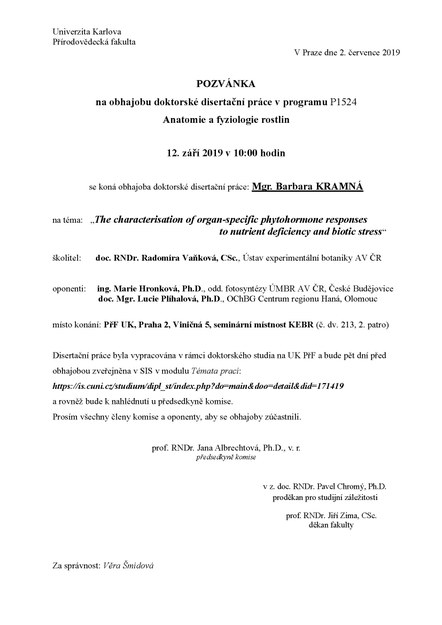Mgr. Barbara KRAMNÁ - obhajoba doktorské disertační práce
Srdečně vás zveme na obhajobu doktorské disertační práce Mgr. Barbory Kramné na téma "The characterisation of organ-specific phytohormone responses to nutrient deficiency and biotic stress“.
| Čas |
12.09.2019 od 10:00 do 12:00 |
|---|---|
| Přiložený soubor: | 190912_Kramna.pdf |
| Další soubor: | 190912_Kramna_abstrakt.pdf |
| Přidat událost do kalendáře |
|
ABSTRACT
Abiotic and biotic stresses lead to crop yield losses and ultimately negatively affect agriculture production. Elucidation of the mechanisms of plant stress responses and their regulation could help to understand plant defence and improve stress tolerance. Phytohormones stand behind both plant growth and developmental changes as well as stress signalling. This thesis summarises the results published in two articles focused on phytohormone dynamics in response to abiotic and biotic stresses, namely phosphate shortage and Plasmodiophora brassicae infection. A review article focuses in depth on strigolactones as master regulators of phosphate deficiency responses. The main emphasis is put on organ-specific reactions and exogenous phytohormone treatment with the potential to convey stress tolerance.
In the case of phosphate shortage, the universal reaction in all organs was a decrease in active cytokinin trans-zeatin and gibberellin GA4 with a concurrent elevation of abscisic acid. Also, the high-affinity phosphate transporters (PHT1;4 and PHT1;7) exhibited increased gene expression within the whole plant. Shoot apical meristems showed numerous changes in gene expression and were the most affected organ during the lack of phosphate. Only in roots, we observed a substantial elevation of low active cytokinin cis-zeatin. Exogenous application of a strigolactone analogue rac-GR24 in the presence of phosphate generally mimicked the impact of phosphate starvation.
Strigolactones are a carotenoid group of phytohormones, and their biosynthesis is conserved within the plant kingdom. Homologous enzymes were identified in moss Physcomitrella patens, monocots such as rice and maize, and also dicots including tomato, Arabidopsis and poplar. In the case of signalling, the first land plants differ from the vascular ones, and strigolactones seem to act via other receptors and influence predominantly light responses.
The biotic stress reactions to biotrophic pathogen Plasmodiophora brassicae varied in susceptible and resistant Brassica cultivars. The susceptible one, Hornet, exhibited during infection prolonged maintenance of elevated content of growth-promoting hormones, auxin and cytokinins. The resistant one, Alister, had higher basal levels of salicylic acid. Exogenous treatment of salicylic acid reduced disease symptoms in Alister and predominantly enhanced its content, down-regulating jasmonic acid levels in roots. Exogenous jasmonic acid promoted infection in both cultivars via stimulation of cytokinins and expression of cytokinin and auxin biosynthetic genes.
This thesis highlights the organ-specific responses to stress conditions and discuss the potential of strigolactone and salicylic acid application for improving stress resilience. It also characterises the general and specific reactions during abiotic vs biotic stresses.
Keywords: phosphate deficiency, rac-GR24, strigolactones, jasmonic acid, salicylic acid, Plasmodiophora brassicae, resistance, phytohormones, gene expression
Publikováno:
Neděle 01.09.2019 00:05
Akce dokumentů
